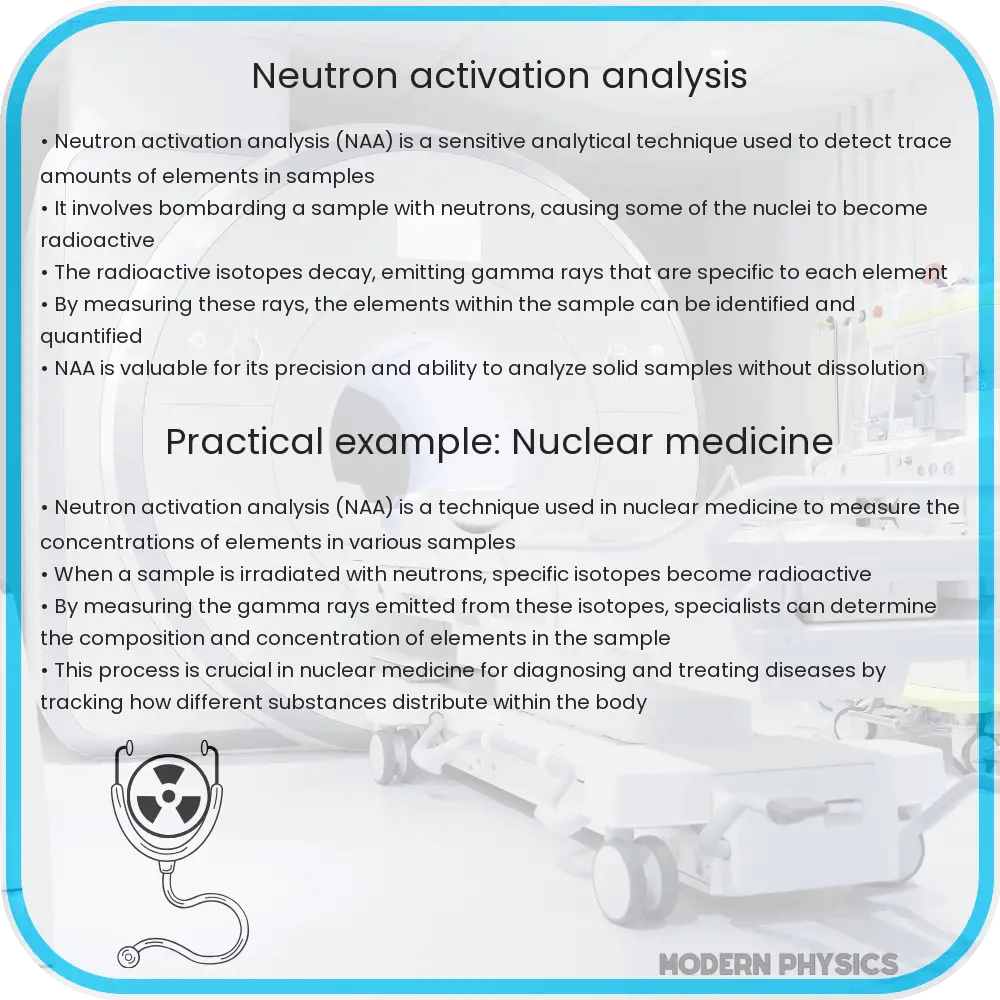Learn about Neutron Activation Analysis, a precise non-destructive method used to identify elemental composition in various materials through neutron irradiation and gamma-ray spectrometry.

Introduction to Neutron Activation Analysis
Neutron Activation Analysis (NAA) is a highly sensitive and precise technique used in the field of material and environmental science for analyzing the compositions of various substances. This non-destructive analytical method involves bombarding samples with neutrons, causing some of the nuclei in the sample to capture these neutrons and, in turn, become radioactive. By measuring the resultant gamma rays emitted from these radioactive isotopes, it is possible to determine the concentration and type of elements present in the original sample.
The Process of Neutron Activation Analysis
The basic principle behind NAA revolves around the nuclear reaction that occurs when an atom in the sample captures a neutron. This process alters the atomic structure, leading to a configuration that is often unstable. To regain stability, the isotopes decay, emitting gamma rays in distinctive energies and intensities that are characteristic of specific elements. These emissions are captured and analyzed using a gamma-ray spectrometer, which allows for precise element identification.
The typical steps involved in NAA are:
- Sample Preparation: Small samples are prepared, ensuring they are pure and representative of the material to be analyzed.
- Neutron Irradiation: The prepared sample is exposed to a flux of neutrons, usually sourced from a nuclear reactor.
- Gamma-ray Spectrometry: After irradiation, the sample exhibits radioactivity briefly. The emitted gamma rays are detected and their energy and intensity are measured.
- Data Analysis: Specialists interpret the gamma-ray spectra to identify and quantify the elements within the sample.
Advantages of Neutron Activation Analysis
NAA offers numerous benefits, making it a valuable tool in various sectors:
- Non-Destructive: Unlike many analytical techniques, NAA does not alter or destroy the sample being analyzed, which is particularly useful for archaeological and forensic investigations.
- Sensitivity: NAA is capable of detecting very low concentrations of elements, down to parts per million or even parts per billion.
- Simultaneous Multi-Element Analysis: This method can identify multiple elements in a single sample simultaneously, enhancing efficiency.
- Accuracy: NAA provides highly accurate quantitative and qualitative data on the elemental composition of a sample.
Applications of Neutron Activation Analysis
NAA is utilized in a variety of fields due to its precision and reliability. Some of its key applications include:
- Environment Studies: Used for analyzing soil and water samples to detect pollution and trace elements critical to environmental conservation.
- Material Science: Helps in determining the composition of metals, ceramics, and other composite materials, supporting quality control and research.
- Archaeology: Assists in the chemical analysis of archaeological artifacts, aiding in the determination of their composition, origin, and age.
- Forensics: Applied in forensic science for trace evidence analysis such as glass particles, metal residues, and other minute samples.
- Medicine and Health: Utilized for analyzing biological samples and for long-term toxicological studies.
The widespread usability of Neutron Activation Analysis underscores its importance in not just scientific inquiries but also in practical applications across various sectors, demonstrating the intersection of physics with everyday life and industry challenges.
Limitations and Considerations of Neutron Activation Analysis
While NAA offers significant advantages, it also presents certain limitations that must be considered:
- Requires a Neutron Source: The need for a neutron source, typically a nuclear reactor, can limit the accessibility and usage of NAA due to logistical, regulatory, and safety considerations.
- Radiation Concerns: Handling radioactive materials necessitates stringent safety protocols to protect researchers and the environment from radiation exposure.
- Interference Issues: Certain elements may produce overlapping gamma-ray peaks, which can complicate the analysis and require sophisticated software and expertise to decipher.
- Cost: The operation of nuclear reactors and the maintenance of high-quality spectrometry equipment involve significant costs, making NAA more expensive than some other analytical methods.
Future Prospects of Neutron Activation Analysis
The ongoing advancements in nuclear technology and analytical techniques continue to broaden the horizons for NAA. Improvements in detector efficiency, data processing algorithms, and neutron sources are expected to mitigate many of the current limitations. Additionally, the development of portable neutron sources could someday expand the accessibility of this powerful analytical method, making it feasible for more widespread use in field applications. The integration of NAA with other analytical techniques could also provide more comprehensive insights, further enhancing its utility in research and industry.
Conclusion
Neutron Activation Analysis stands out as a unique and powerful technique in the vast landscape of analytical methods. Its non-destructive nature, ability to analyze a wide range of elements simultaneously, and exceptional sensitivity make it an indispensable tool in fields as diverse as environmental science, archaeology, and forensics. Although challenges such as the need for a neutron source and associated radiation safety concerns require careful management, the benefits of NAA often outweigh these limitations. With ongoing technological advancements, the future of NAA looks promising, offering the potential for even greater contributions to scientific discovery and practical applications in various sectors.
